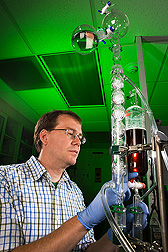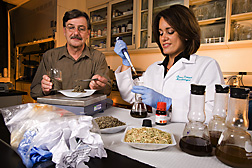From Garbage to Gas
Converting City Refuse and Farm Leftovers to Clean Energy
It’s a trashy idea. And it’s one that everyone concerned about gas prices—and the environment—will surely love.
The idea is to combine household garbage and other urban trash—known as “municipal solid waste” (MSW)—with after-harvest leftovers from fields, orchards, and vineyards to create ethanol and other forms of bioenergy.
This straightforward, eco-friendly strategy is one that ARS scientists at the Western Regional Research Center in Albany, California, and their colleagues are pursuing full bore. The scientists, with the Bioproduct Chemistry and Engineering Research Unit, are collaborating in this ambitious research and development with Comprehensive Resources, Recovery, and Reuse, Inc., or CR3, of Reno, Nevada, and the Salinas (California) Valley Solid Waste Authority.
From a biofuels-chemistry point of view, MSW is a treasure trove of cellulose—the fiber that can be converted into ethanol.
According to unit leader Bill Orts, about 30 to 40 percent of household garbage is paper—newspaper, used paper towels, or cardboard boxes. Since paper is cellulose, and cellulose can be readily fermented to make ethanol, “you’re looking at a substrate that’s half the way to becoming a biofuel,” says colleague Kevin Holtman, a chemist with the Albany unit. “The papermakers did the first 50 percent of the conversion for us when they converted wood into paper.”
Equally underused as an energy resource is the abundant, diverse array of agricultural wastes (ag waste) like rice straw, almond hulls, the oversized outer leaves of iceberg lettuce—and much more.
The researchers intend to tap these farm and city resources as energy-rich feedstocks to test at a proof-of-concept facility now under development at a Salinas Valley landfill. Orts, Holtman, Albany microbiologist Diana Franqui, and engineering technician David Bozzi are all part of the garbage-to-gas team.
In most instances, ag waste would have to be pretreated before being used as a bioenergy resource, Holtman notes. He’s determining the best ways to use just heat and water—instead of hazardous chemicals—to pretreat the ag wastes and keep the biorefining process “green.”
The MSW would also be pretreated. That would take place in a 2-ton-capacity autoclave, developed and patented by CR3. The autoclave acts like a giant pressure cooker, converting the MSW into grey, lightweight clumps. The pretreated ag waste and autoclaved MSW would then be transferred to a biofermenter. Enzymes and yeasts would be added to make ethanol.
Plans call for expanding the pilot facility at the landfill, where the autoclave is now installed, into a complete biorefinery. “We’ll use new and off-the-shelf technologies to show that our system is flexible enough to incorporate a wide variety of waste streams, from season to season, harvest to harvest, year to year,” says Holtman. “And even though the price and availability of the ag waste stream may vary, the MSW stream is endless and is a solid economic foundation to keep a biorefinery running.
“MSW is produced year round and is already collected and transported near population centers,” he points out. “That means the biorefinery won’t be based on the tight economics associated with traditional crop-to-ethanol operations.”
“The kind of ‘green’ biorefinery that we’re developing would reduce the volume of existing landfills, decrease the need for new ones, and minimize greenhouse gas production,” says Orts. Blending city and farm refuse into feedstocks “is an economically and environmentally sound alternative for producing biofuels,” he says. Best of all, “it’s an alternative for the here and now—not something that’s 10 years down the road.”—By Marcia Wood, Agricultural Research Service Information Staff.
This research is part of Bioenergy and Energy Alternatives, an ARS national program (#307) described on the World Wide Web at www.nps.ars.usda.gov.
To reach scientists mentioned in this article, contact Marcia Wood, USDA-ARS Information Staff, 5601 Sunnyside Ave., Beltsville, MD 20705-5129; phone (301) 504-1662, fax (301) 504-1486.
"From Garbage to Gas: Converting City Refuse and Farm Leftovers to Clean Energy" was published in the October 2008 issue of Agricultural Research magazine.








